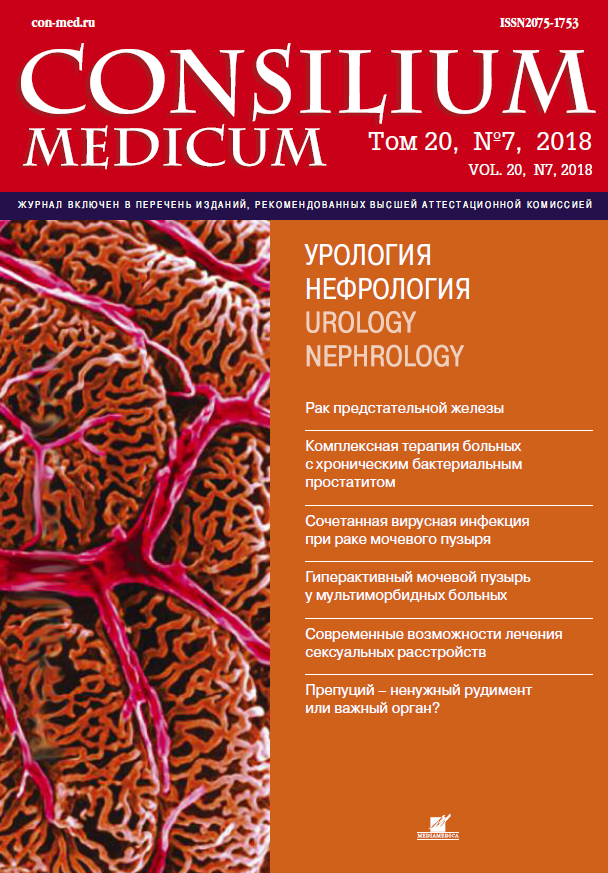Influence of urethrovesical anastomosis reconstruction variants use in radical prostatectomy on urinary continence recovery
- Authors: Golubtsova E.N1,2, Tomilov A.A2, Veliev E.I1,2
-
Affiliations:
- Russian Medical Academy of Continuous Professional Education of the Ministry of Health of the Russian Federation
- S.P.Botkin City Сlinical Hospital of the Department of Health of Moscow
- Issue: Vol 20, No 7 (2018)
- Pages: 26-29
- Section: Articles
- URL: https://bakhtiniada.ru/2075-1753/article/view/94979
- DOI: https://doi.org/10.26442/2075-1753_2018.7.26-29
- ID: 94979
Cite item
Full Text
Abstract
Full Text
##article.viewOnOriginalSite##About the authors
E. N Golubtsova
Russian Medical Academy of Continuous Professional Education of the Ministry of Health of the Russian Federation; S.P.Botkin City Сlinical Hospital of the Department of Health of Moscow
Email: engolubtsova@yandex.ru
ассистент каф. урологии и хирургической андрологии; врач-уролог 41-го урологического отд-ния 125993, Russian Federation, Moscow, ul. Barrikadnaia, d. 2/1; 125284, Russian Federation, Moscow, 2-i Botkinskii pr-d, d. 5
A. A Tomilov
S.P.Botkin City Сlinical Hospital of the Department of Health of Moscowврач-уролог 56-го урологического отд-ния 125284, Russian Federation, Moscow, 2-i Botkinskii pr-d, d. 5
E. I Veliev
Russian Medical Academy of Continuous Professional Education of the Ministry of Health of the Russian Federation; S.P.Botkin City Сlinical Hospital of the Department of Health of Moscowпроф. каф. урологии и хирургической андрологии 125993, Russian Federation, Moscow, ul. Barrikadnaia, d. 2/1; 125284, Russian Federation, Moscow, 2-i Botkinskii pr-d, d. 5
References
- Abdollah F, Sood A, Sammon J.D et al. Long-term cancer control outcomes in patients with clinically high-risk prostate cancer treated with robot-assisted radical prostatectomy: results from a multi-institutional study of 1100 patients. Eur Urol 2015; 68: 497-505.
- Cooperberg M.R, Carroll P.R. Trends in management for patients with localized prostate cancer, 1990-2013. JAMA 2015; 314: 80-2.
- Sukumar S, Rogers C.G, Trinh Q.D et al. Oncological outcomes after robot-assisted radical prostatectomy: long-term follow-up in 4803 patients. BJU Int 2014; 114: 824-31.
- Ficarra V, Novara G, Rosen R.C et al. Systematic review and meta-analysis of studies reporting urinary continence recovery after robot-assisted radical prostatectomy. Eur Urol 2012; 62: 405-17.
- Noguchi M, Kakuma Т, Suekane S еt al. A randomized clinical trial of suspension technique for improving early recovery of urinary continence after radical retropubic prostatectomy. BJU Int 2008; 102: 958-63.
- Patel V.R, Coelho R.F, Palmer K.J et al. Periurethral suspension stitch during robot-assisted laparoscopic radical prostatectomy: description of the technique and continence outcomes. Eur Urol 2009; 56: 472-8.
- Bahler C.D, Sundaram C.P, Kella N et al. A parallel randomized clinical trial examining the return of urinary continence after robotassisted radical prostatectomy with or without a small intestinal submucosa bladder neck sling. J Urol 2016; 196: 179-84.
- Cestari A, Ferrari M, Ghezzi M et al. Retropubic intracorporeal placement of a suburethral autologous sling during robot-assisted radical prostatectomy to improve early urinary continence recovery: preliminary data. J Endourol 2015; 29: 1379-85.
- Walz J, Burnett A.L, Costello A.J et al. A critical analysis of the current knowledge of surgical anatomy related to optimization of cancer control and preservation of continence and erection in candidates for radical prostatectomy. Eur Urol 2010; 57: 179-92.
- Costello A.J, Dowdle B.W, Namdarian B et al. Immunohistochemical study of the cavernous nerves in the periprostatic region. Bju Int 2010; 107, 1210-5.
- Tewari A.K, Ali A, Ghareeb G et al. Improving time to continence after robot-assisted laparoscopic prostatectomy:augmentation of the total anatomic reconstruction technique by adding dynamic detrusor cuff trigonoplasty and suprapubic tube placement. J Endourol 2012; 26: 1546-52.
- Lim S.K, Kim K.H, Shin T.Y et al. Current status of robot-assisted laparoscopic radical prostatectomy: how does it compare with other surgical approaches? Int J Urol 2013; 20: 271-84.
- Galfano A, Trapani D, Sozzi F et al. Beyond the learning curve of the retzius-sparing approach for robot-assisted laparoscopic radical prostatectomy: oncologic and functional results of the first 200 patients with ≥1 year of follow-up. Eur Urol 2013; 64: 974-80.
- Lim S.K, Kim K.H, Shin T.Y et al. Retzius-sparing robot-assisted laparoscopic radical prostatectomy: combining the best of retropubic and perineal approaches. BJU Int 2014; 114 (2): 236-44.
- Rocco B, Cozzi G, Spinelli M.G et al. Posterior musculofascial reconstruction after radical prostatectomy: a systematic review of the literature. Eur Urol 2012; 62: 779-90.
- Ghani K.R, Menon M. Posterior reconstruction: weighing the evidence. Eur Urol 2012; 62: 791-3.
- Jeong W, Lee J.K, Oh J.J et al. Effects of New 1-Step Posterior Reconstruction Method on Recovery of Continence after Robot-Assisted Laparoscopic Prostatectomy: Results of a Prospective, Single-Blind, Parallel Group, Randomized, Controlled Trial Chang. J Urol 2015; 193 (3): 935-42.
- Student V.Jr, Vidlar A, Grepl M et al. Advanced Reconstruction of Vesicourethral Support (ARVUS) during Robot-assisted Radical Prostatectomy: One-year Functional Outcomes in a Two-group Randomised Controlled Trial. Eur Urol 2017; 71 (5): 822-30.
- Gratzke C, Dovey Z, Novara G et al. Early Catheter Removal after Robot-assisted Radical Prostatectomy: Surgical Technique and Outcomes for the Aalst Technique (ECaRemA Study). Eur Urol 2016; 69 (5): 917-23.
- Porpiglia F, Bertolo R, Manfredi M et al. Total Anatomical Reconstruction During Robot-assisted Radical Prostatectomy: Implications on Early Recovery of Urinary Continence. Eur Urol 2016; 69 (3): 485-95.
Supplementary files






